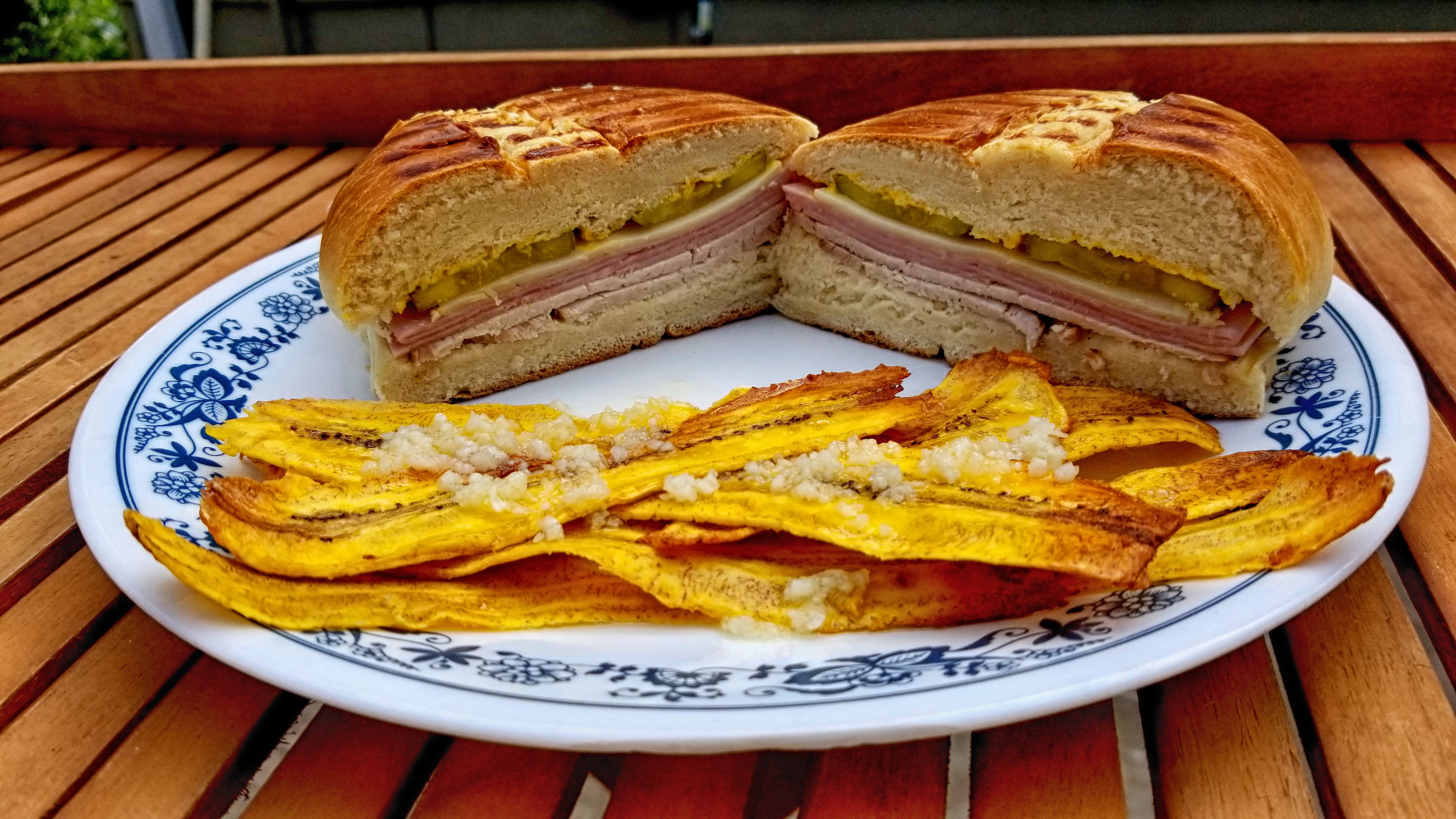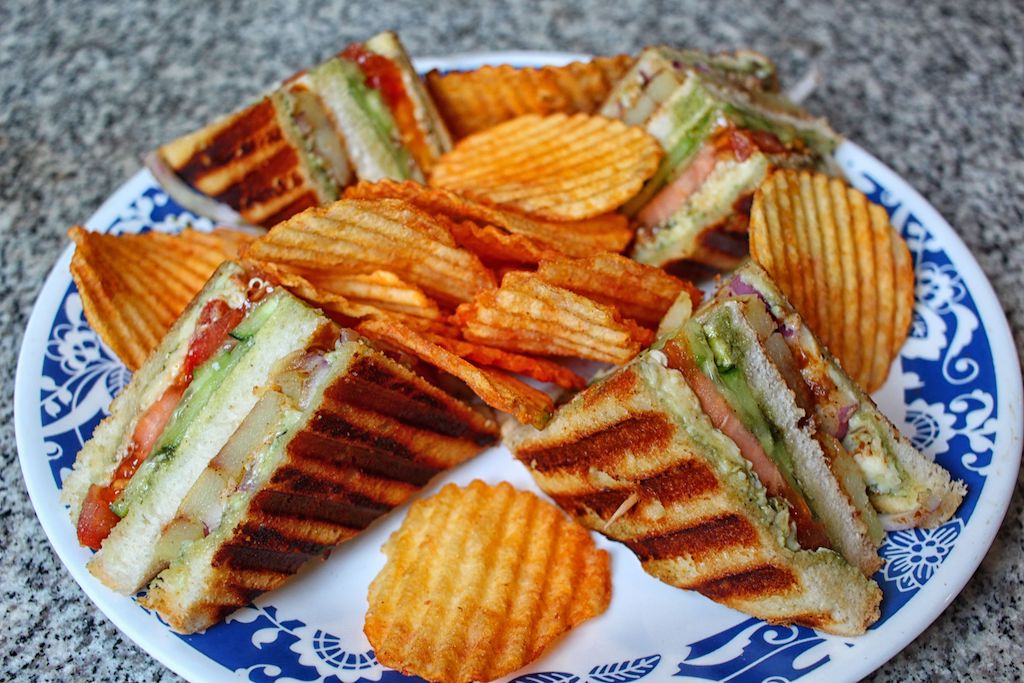Senegalese Pain Ndambe
In 2019, the website Thrillist declared the Summer of the Sandwich, with articles celebrating the sandwich in its many forms, anchored by a massive piece called Around The World In 80 Sandwiches. If this opening sounds familiar, it’s because I’ve brought it up before–the piece refers to me as an “enterprising investigative sandwich blogger,” a title that I’m still crowing about 5 years later. But I also bring it up frequently because at that time, we were still in our first run through the Wikipedia List of Sandwiches and this article introduced several sandwiches that before then were not on our radar: Khao Jee, Moo Yong, the Taiwanese Breakfast sandwich, Boh Lah Yau, Korokke Pan, Bake and Shark, Peameal Bacon, and a sandwich that the article simply referred to as “Bean Sandwich.”
The popular, unpretentious West African breakfast sandwich is essentially a choose-your-own-adventure that starts with a few simple elements: red beans cooked in a spicy tomato paste with onions and myriad spices; baguettes, an essential part of most any Senegalese breakfast (and a reminder of its French occupation until 1960); and a generous helping of mayonnaise and hot sauce. From there, you can get wild and throw in eggs, potatoes, onion sauce, or even pasta. At some street vendors, it’s a little more DIY — you go to the bakery, get the baguette, they add the magic, and wrap it in yesterday’s newspaper, giving you both a delicious sandwich AND the satisfying opportunity to finish someone else’s crossword.
The only real identifying information they give in the writeup is that the sandwich hails from Senegal. This triggered a memory though, a memory of Anthony Bourdain sitting on a bench next to a street food stall, eating a baguette filled with some mysterious “good stuff.” Bourdain gave the sandwich a name though: Ndambe.
…what people have described as a bean sandwich, but is really a spread of spicy lentils on a baguette. You buy your baguette at the bakery, bring it over to the nice lady. She slathers on the good stuff, and there you go. And it is indeed, addictively delicious.
And back in 2019 when I remembered this, I decided to make the sandwich. I never wrote about it at the time–I was still not sure whether to call it Ndambe or “Senegalese bean sandwich” or what. And all the recipes for Ndambe that I found had some type of meat in them, usually lamb though sometimes beef. Neither Bourdain nor Thrillist had said anything about meat, and I kept looking for a recipe that appeared to match what Anthony Bourdain ate outside that bakery in Saint-Louis.
Eventually I found such a recipe on YouTube–which spelled the dish “Nbambe” rather than Ndambe. It, as well as nearly every other recipe I’ve seen for Ndambe, uses black-eyed peas, not lentils. But this recipe seems right in a way that the recipes using lamb do not, a simple, meatless recipe that a woman selling bean dip outside a bakery on a dusty side-street in Senegal might make.
Here is my interpretation of that recipe. The jumbo “cubes” I bought seemed wider than standard bouillon cubes but once I took them out of the package they appeared to not be nearly as thick as what she used in the video, so I supplemented by using more of them. Also I took the extra step of soaking the beans overnight, and used more water than I needed probably, necessitating a longer cook time.

The result was a bean spread that, though it still had the texture of some whole beans in it, was largely made up of delicious, well-seasoned bean mush.
Ndambe
Ingredients
- 1 lb dried black-eyed peas
- water to cover
- 2 quarts water
- 1 tsp kosher salt
- 1/4 cup palm oil
- 1 large yellow onion diced
- 4 cloves garlic
- 3 jumbo seasoning cubes
- 2 habanero chilies
- 1 tsp kosher salt
- 1 tbsp tomato paste
Instructions
- Clean beans and remove stones, etc. Pour enough water to cover by 2 inches and soak for 8 hours or overnight

- Drain water from beans. Add enough water to cover, mix in 1tsp of salt, and cook beans on low for 30-60 minutes

- While beans are cooking, heat palm oil in a pan and saute onions.
- In a molcajete, mash the jumbo cubes, 1tsp salt, garlic cloves, and habanero peppers to a paste.
- Once onions are translucent and starting to brown a bit, clear a spot in the pan and add tomato paste, letting it start to caramelize against the hot pan before mixing it in.
- Add the garlic mixture and some additional water to the onions and mix together, cooking it down to a paste.
- Mix paste into cooked beans once tender and cook to desired thickness.

I found this bean stew I made every bit as addictively delicious as Anthony Bourdain had described, both when I first made it in 2019 and again this month.

To make the sandwich, I bought myself a good baguette from a local French Bakery, cut off a reasonably-sized hunk of it, split that hunk into top and bottom halves with a hinge along one side, and spread my bean mixture on the bottom half.




That’s It?
Well no, not exactly. A lot of descriptions talk about adding mayonnaise to the sandwich, and the lady who gave Bourdain his Ndambe did spread something on the top half of the baguette, something sort of yellowish/light orangeish/off-white that could have been a very eggy mayonnaise.
But it could also have been a mild chili sauce called sosu kaani often used in Senegalese cuisine that seems like it would make a much better condiment for this sandwich. Sosu kaani is made with onion, tomatoes, garlic, habanero or Scotch bonnet chili pepper, and bay leaf, along with salt and pepper.

Preparing the sauce involves sauteeing the onion, garlic, tomatoes, and chilies in palm oil and simmering them with a bay leaf for a time, then pureeing the mixture in a blender to create a thick, reddish orange sauce that has a big tomato and sweet cooked onion flavor with a bit of kick from the habanero chilies. As you might imagine, it’s a near-ideal accompaniment for these beans, but I won’t shame you if you decide to use mayonnaise instead.

A good, crisp-crusted baguette, a tasty bean spread, and a savory, spicy tomato-chili sauce makes for quite a good sandwich. Black-eyed peas have a nutty flavor that, combined with the cooked onions sweetness, extra umami from the seasoning cubes and tomato paste, and the slight kick of habanero spice, give the Ndambe more than enough flavor to stand on their own, even against a much larger volume of good, crusty, chewy bread. The sosu kaani amplifies the already savory, spicy flavor of the beans as well.

But a crusty, chewy bread like a French baguette is not the best choice for a squishy bean spread. When the crumb of the bread is too firm for the filling of the sandwich, it compresses and pushes the filling out the sides as you bite into it. A softer-crumbed baguette is a better choice in my opinion, so I picked up an extra long from Damato’s, Chicago’s perfect sub sandwich bread.

This was the Ndambe sandwich that I envisioned, the crisp crust of the baguette giving way to a soft crumb that hugged the beans inside rather than pushing them out. Same delicious sandwich, but ten times easier to eat.




And if you scroll back up and look at the baguette Bourdain bought on the streets of Saint-Louis, it isn’t a hard, dark brown, chewy jaw-ache-inducing “proper” baguette but rather soft, rather thin, a bit floppy… a good bread for serving beans in. And one thing we insist on here at the Tribunal is that a great sandwich starts not with great bread, but with the right bread. Softer fillings need softer bread, and while I think you could make a good meal simply spreading a highly-flavored bean spread like ndambe on a crusty, chewy baguette, I think a softer crumb works better in sandwich form.
And now I have 2 more quarts of beans and 3.5 more feet of baguette to eat. There are good times ahead!

I like sandwiches.
I like a lot of other things too but sandwiches are pretty great















I agree with your bread opinions. I used to always reach for a hard crusty baguette for all sandwiches, but eventually learned better. A crunchy exterior is always great, but a softer interior is best for squishy ingredients. A Vietnamese banh mi roll (briefly warmed) fits the bill in these situations.
You get it! Thanks for the comment!
Thanks for sharing this! Very timely too – I was staring at my container of black-eyed peas the other day, trying to think of something different to make with them. Problem solved! May I ask what kind of seasoning cubes you used? Something like Maggi?
Very similar, they’re Jumbo brand instead of Maggi though.
I lived in the Gambia for two years – Gambia sits along the river the runs in the middle Senegal so it’s basically surrounded by the country, except for the coast. every morning I had two breakfasts: at home I would have a sweet, rice and ground nut porridge and then I would walk to school, line up with all the kids, and also get one of these sandwiches. they were so good – and vegetarian like you made. wolof is a language spoken in both Senegal and Gambia and mbambe is wolof I think. in Gambia they also speak mandinka ans I think it may be called nyebbeh? also sometimes spelled nebbe? but it’s been a long time so I could be way off. anyway, I love this and can’t wait to make it!!!
What would be a good substitute for palm oil? Thanks!
Hi Elizabeth, a lot of the recipes I’ve seen just use vegetable oil. The palm oil is an authentic ingredient and I happen to have relatively easy access to it but you shouldn’t let it stop you from making this!